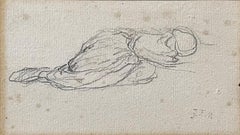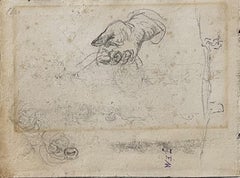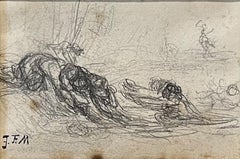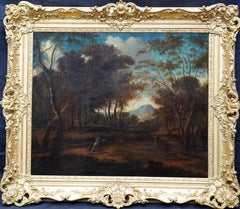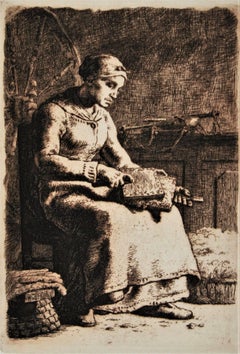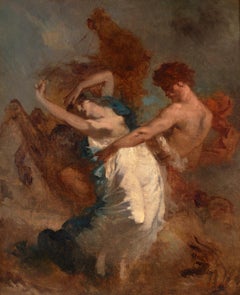Jean François Millet Art
to
4
2
5
2
1
1
1
1
Study of the sleeping woman from "La méridienne"
By Jean François Millet
Located in Barbizon, FR
Study of the sleeping woman from “La meridienne”,
Black pencil drawing on paper (sketchbook), stamped from the widow's sale in 1894 (Lugt L.3728) lower left, Paper 9.2x13.2 cm, drawi...
Category
19th Century Barbizon School Jean François Millet Art
Materials
Paper, Pencil
Study of a hand and landscape, on the back, study of cow legs and hooves
By Jean François Millet
Located in Barbizon, FR
Black pencil drawing, stamp from the widow’s sale in 1894 (Lugt L. 3728), dimensions 10.5x14.2cm. This is a detail study of the hand of the peasant holding a lunge rein, represented...
Category
19th Century Barbizon School Jean François Millet Art
Materials
Pencil
Study of "Hylas and the nymphs", and on the backside, study of a peasant
By Jean François Millet
Located in Barbizon, FR
Black pencil drawing, stamped from the widow’s sale in 1894 (Lugt L. 3728), dimensions 7x10.2cm. It is most likely the first thought for this subject, circa 1846.
On the reverse si...
Category
19th Century Barbizon School Jean François Millet Art
Materials
Pencil
Wooded Landscape with Diana Hunting - 17thC Old Master French art oil painting
By Jean François Millet
Located in London, GB
A original large French Old Master oil on canvas which is by Millet (1642-1679) and was painted circa 1675. This large canvas is in good clean condition and depicts a wooded landscap...
Category
17th Century Old Masters Jean François Millet Art
Materials
Oil
Jean Francois Millet, "La Boullie (The Porridge)", Drypoint Etching, 1861
By Jean François Millet
Located in Long Island City, NY
Etching printed in brownish black on light tan Chine collé, 1861. Image measures 6 x 5 inches, displayed in a 15.5 x 12.5 inch frame. Etched signature and date lower left. A very goo...
Category
1860s Impressionist Jean François Millet Art
Materials
Drypoint, Etching, Intaglio
La Cardeuse (Woman Carding Wool)
By Jean François Millet
Located in Storrs, CT
La Cardeuse (Woman Carding Wool). c. 1858. Etching. Delteil, Melot 15. only state. 10 x 7 (sheet 12 3/8 x 9 1/2). Illustrated: Print Collector's Quarterly 25 (1938): 146; Keppel, The...
Category
1850s Barbizon School Jean François Millet Art
Materials
Etching
Related Items
Two Seated Men
By Henri Lebasque
Located in New York, NY
“Two Seated Men” by Henri Lebasque (1865-1937)
Pencil and watercolor on paper
6 x 5 inches unframed (15.24 x 12.7 cm)
Signed on bottom right
Description:
In ...
Category
20th Century Jean François Millet Art
Materials
Watercolor, Pencil
Weltevreden, Kebon Sirih, & Vlucht voor de bui (Fleeing the rain)
Located in Amsterdam, NL
Weltevreden, Kebon Sirih, & Vlucht voor de bui (Fleeing the rain)
Executed between February 20 and March 2, 1918
Double sided drawing in graphite pencil on paper
Images: c. 33 x 5...
Category
1910s Art Nouveau Jean François Millet Art
Materials
Paper, Graphite
Free Shipping
H 19.3 in W 23.63 in D 1.19 in
Commonitorium- 21st Century, Contemporary, Figurative, Pigment Print, Portrait
By Ger Doornink
Located in Barcelona, Catalonia
Edition of 50
Ger Doornink's limited editions are based on a high resolution scan of the original artwork. They are printed on archival Hahnemühle German Etching paper. This techniq...
Category
21st Century and Contemporary Contemporary Jean François Millet Art
Materials
Archival Paper, Etching
Two Balinese Beauties (Mapeed), circa 1945
By Johan Rudolf Bonnet
Located in Amsterdam, NL
Rudolf Bonnet (1895-1978)
'Mepèèd' (Mapeed)
Signed lower right
Titled upper right
Pastel on gouache pigmented paper, 57 x 34 cm
In original carved ebo...
Category
1940s Jean François Millet Art
Materials
Paper, Crayon, Pastel, Gouache, Pencil
Free Shipping
H 22.45 in W 13.39 in D 0.04 in
François-Édouard Picot (French 1786-1868) Greek Comedy Play 19th Century Drawing
By François-Édouard Picot
Located in Meinisberg, CH
François-Édouard Picot
(French, 1786 – 1868)
Ancient Greek Comedy Play
• Pencil Drawing on laid paper behind decorative matting, visible image, ca. 10.5 x 15.5 cm
• Modern Glased frame, ca. 27 x 33 cm
• Signed "Picot fecit" lower left
• As we photographed through glass, there are reflections in the images
Worldwide shipping is complimentary - There are no charges for handling & delivery
Here we have the somewhat unusual, yet typical subject matter François-Édouard Picot was interested in depicting. Shown is a scene from an ancient Greek comedy play. The previous owner has noted on the back, that this image was copied from an ancient Greek stone relief.
François-Édouard Picot was born on the 10th of October in 1786 in Paris, France. He studied with various masters and became well known for his historical and mythological subjects. In 1812 he won the second prize in the Prix de Rome competition and after that success, went on to exhibit at the Paris Salon, where in the year 1819 he won a first-class medal for his neoclassical L'Amour et Psyché, which today hangs in the Louvre in Paris. He regularly exhibited his work in the salon up to 1839. He taught several young great artists at his elitist studio and was known for accepting only very few students, which included William Bouguereau, Gustave Moreau, Cabanel and Paul Seignac...
Category
Early 19th Century Naturalistic Jean François Millet Art
Materials
Laid Paper, Pencil
Free Shipping
H 10.63 in W 13 in D 1.19 in
Village Northern Bali, 1906
Located in Amsterdam, NL
Premises in North Bali, 1906
Signed with initials and titled bottom left and fully signed, bottom right
Pencil and ink on paper, 10.5 x 18 cm
Black ebonized frame with white mount
...
Category
Early 1900s Art Nouveau Jean François Millet Art
Materials
Paper, Graphite
Costume drawings for ‘Ambassadeur de Siam’ and ‘La Sultana Reine’
Located in Amsterdam, NL
Joseph-Marie Vien (1716-1809)
‘Ambassadeur de Siam’ and ‘La Sultana Reine’
Both titled lower centre, the drawing of the ambassador inscribed with colours intended for the prints, e...
Category
Mid-18th Century Old Masters Jean François Millet Art
Materials
Paper, Pencil
Free Shipping
H 9.26 in W 6.89 in D 1.19 in
LES LAVEUSES, loire valley, french landscape scene, oil by Henri DutzchoildD
Located in York, GB
A lovely tranquil scene of LES LAVEUSES.
Depicting houses by a stream/river with a woman washing her laundry.Framed Oil on canvas Signed and dated '74'(lower right)
The size being...
Category
19th Century Old Masters Jean François Millet Art
Materials
Oil
Free Shipping
H 24.02 in W 18.9 in
Dans les Cendres (In the embers)
By Albert Besnard
Located in Storrs, CT
Dans les Cendres (In the embers). 1887. Delteil catalog 67 state iii. State after the plate was cut down and a second figure eliminated (the two earlier states are of the greatest rarity). Etching, drypoint and roulette. 16 3/4 x 12 1/8 (sheet 19 1/2 x 14). Edition 50. Illustrated: Print Collector's Quarterly 9 (1921): 254. A very rich impression with plate tone and drypoint burr, printed on simili-japon. Provenance: Frederick Keppel & Co. This is one of the artist's most striking images. Signed in pencil. Housed in 25 x 20-inch archival mat, suitable for framing.
Paul Albert Besnard, was an impressionist painter. In 1866, the seventeen-year-old son of artist parents began his studies at the École des Beaux-Arts Paris. In 1874, Besnard won the important Prix de Rome, with which the academy distinguished young talent. A portion of the scholarship is a stay of several years in Rome. Besnard married Charlotte Dubray, a sculptress, during this time in Rome. The couple lived in England, where Besnard exhibited at the Royal Academy London, between 1881 and 1884. He became involved with English portrait painting during this period, which had a lasting influence on his work.
In the years that followed, Besnard broke with the academic tradition. In 1886, he presented the portrait of Madame Roger Jourdain...
Category
Late 19th Century Impressionist Jean François Millet Art
Materials
Drypoint, Etching
Early oil depicting the Great Fire of London
Located in London, GB
The Great Fire of London in September 1666 was one of the greatest disasters in the city’s history. The City, with its wooden houses crowded together in narrow streets, was a natural fire risk, and predictions that London would burn down became a shocking reality. The fire began in a bakery in Pudding Lane, an area near the Thames teeming with warehouses and shops full of flammable materials, such as timber, oil, coal, pitch and turpentine. Inevitably the fire spread rapidly from this area into the City. Our painting depicts the impact of the fire on those who were caught in it and creates a very dramatic impression of what the fire was like. Closer inspection reveals a scene of chaos and panic with people running out of the gates. It shows Cripplegate in the north of the City, with St Giles without Cripplegate to its left, in flames (on the site of the present day Barbican). The painting probably represents the fire on the night of Tuesday 4 September, when four-fifths of the City was burning at once, including St Paul's Cathedral. Old St Paul’s can be seen to the right of the canvas, the medieval church with its thick stone walls, was considered a place of safety, but the building was covered in wooden scaffolding as it was in the midst of being restored by the then little known architect, Christopher Wren and caught fire. Our painting seems to depict a specific moment on the Tuesday night when the lead on St Paul’s caught fire and, as the diarist John Evelyn described: ‘the stones of Paul’s flew like grenades, the melting lead running down the streets in a stream and the very pavements glowing with the firey redness, so as no horse, nor man, was able to tread on them.’
Although the loss of life was minimal, some accounts record only sixteen perished, the magnitude of the property loss was shocking – some four hundred and thirty acres, about eighty per cent of the City proper was destroyed, including over thirteen thousand houses, eighty-nine churches, and fifty-two Guild Halls. Thousands were homeless and financially ruined. The Great Fire, and the subsequent fire of 1676, which destroyed over six hundred houses south of the Thames, changed the appearance of London forever. The one constructive outcome of the Great Fire was that the plague, which had devastated the population of London since 1665, diminished greatly, due to the mass death of the plague-carrying rats in the blaze.
The fire was widely reported in eyewitness accounts, newspapers, letters and diaries. Samuel Pepys recorded climbing the steeple of Barking Church from which he viewed the destroyed City: ‘the saddest sight of desolation that I ever saw.’ There was an official enquiry into the causes of the fire, petitions to the King and Lord Mayor to rebuild, new legislation and building Acts. Naturally, the fire became a dramatic and extremely popular subject for painters and engravers. A group of works relatively closely related to the present picture have been traditionally ascribed to Jan Griffier...
Category
17th Century Old Masters Jean François Millet Art
Materials
Oil, Canvas
19th Century Oil Farmer And Bull Country Landscape Scene After Aelbert Cuyp
By Aelbert Cuyp
Located in York, GB
After Aelbert Cuyp (unsigned) an oil on board country scene depicting a farmer and bull. The painting is in overall very good condition however the frame has some losses .Mainly to...
Category
19th Century Old Masters Jean François Millet Art
Materials
Oil
Free Shipping
H 14.97 in W 18.12 in D 1.58 in
La Loge (The Lodge) /// Post-Impressionist Figurative French Paris People Art
By Louis Legrand
Located in Saint Augustine, FL
Artist: Louis LeGrand (French, 1863-1951)
Title: "La Loge (The Lodge)"
Portfolio: Gazette des Beaux-Arts
*Issued unsigned, though signed by LeGrand in the plat...
Category
1910s Post-Impressionist Jean François Millet Art
Materials
Drypoint, Etching, Intaglio
Previously Available Items
Le Semeur
By Jean François Millet
Located in New York, NY
A superb, dark impression of this lithograph, with strong contrasts and with all the subtle tonal variations distinct. Printed in brownish black on anti...
Category
1850s Realist Jean François Millet Art
Materials
Lithograph
The Abduction of the Sabine Women
By Jean François Millet
Located in New Orleans, LA
This dynamic oil on canvas represents one of the most recognized subjects of art history by one of the most important artists of the 19th century. Entitled The Abduction of the Sabine Women, it was composed by the great Jean-François Millet, a painter who is rightfully celebrated as the master of the peasant. Rather than a sower or field laborer, however, this early work captures a mythological narrative, a remarkable rarity for this painter. The dramatic story lends Millet the opportunity to display his command of figure, gesture and tone, revealing the earliest hints of the Realist style that would come to define his artistic genius.
This tempestuous scene of a woman being abducted by a man on horseback was composed at a critical point in Millet’s career. After studying at the École des Beaux-Arts under the tutelage of the history painter Paul Delaroche, Millet achieved modest success as a portrait and genre painter. Yet, by the 1840s, he sought to establish himself on a larger stage and began working on classical and historical compositions for the Paris Salon with emphasis on the human figure. The Abduction of the Sabine Women is among his finest compositions during this important period.
The narrative refers to an incident in Roman mythology when Roman men abducted women from a neighboring region — known as the Sabines — to take as wives. Under the direction of their founder Romulus, the Romans sought to form peaceful alliances with their neighbors and formally requested the rights of marriage with neighboring tribes. Rome's emissaries, however, were unsuccessful, so Romulus decided upon more drastic measures in order to ensure the security and future of his city. According to Levy, during the festival of Neptune Equester, the Romans successfully fought off the Sabine men and captured the young Sabine virgins, who they then married. Though the action initially resulted in war between the two nations, eventually peace was won thanks to the intervention of the Sabine women, who begged for unity between their families and their new husbands.
Throughout art history, The Abduction of the Sabine Women has been depicted by modern and old masters from Giambologna’s 16th-century marble sculpture to masterpieces in oil by Nicolas Poussin, Peter Paul Rubens, Jacques-Louis David and Pablo Picasso. Millet's treatment of the subject reveals his own influences, most specifically the great French Romantic painter Eugène Delacroix.
Although the subject pays homage to Jacques-Louis David’s Neoclassicism, Millet’s use of broad, quick brushstrokes and strong color notes of deep blue-greens and oranges displays a Romantic treatment. In assessing this painting, Millet expert Alexandra Murphy writes, “Only a few documented works survive from this period, and [the] painting is important as a reminder that Millet was looking to the example of Delacroix’s work even more than to his own master, Delaroche.”
Within a few years of creating the work, Millet turned to realistic subjects and moved to Barbizon, where he lived for the rest of his life. By the 1870s, the artist’s work was well established in Boston collections, but it wasn’t until the 1880s that Millet’s popularity spread to other parts of the country. In 1886, two important painting auctions took place in New York at the American Art Galleries: the sale of the Estate of Mrs. Charles Morgan...
Category
19th Century Realist Jean François Millet Art
Materials
Canvas, Oil
La Bouille - Original Etching by J. F. Millet - 1861
By Jean François Millet
Located in Roma, IT
Image dimensions 18.5x15.7 cm.
Original etching by J.F. Millet, signed on plate lower left "J.F. Millet 1861".
Very good conditions.
Ref. Delteil, 17; Degas, 215; Prouté, 1971.
This...
Category
1860s Naturalistic Jean François Millet Art
Materials
Etching
H 11.42 in W 7.09 in D 0.04 in
LES GLANEUSES
By Jean François Millet
Located in Santa Monica, CA
JEAN-FRANCOIS MILLET (1814 – 1875)
LES GLANEUSES, 1855 (Delteil 12 iii/iii)
Etching 7 ½ x 10". On tissue thin paper. Probably...
Category
1850s Barbizon School Jean François Millet Art
Materials
Etching
Paysan rentrant du fumier
By Jean François Millet
Located in Barbizon, FR
Etching, first state from IV, listed by L Delteil under n° 11
provenance: collection G.M. ADAMS ( stamp)
Category
Mid-19th Century Barbizon School Jean François Millet Art
Materials
Etching
L'hiver
By Jean François Millet
Located in Roma, IT
L'hiver is an original etching realized by Jean-François Millet and printed by Cornillot. Perfect conditions. Etching and aquatint representing a natur...
Category
1890s Modern Jean François Millet Art
Materials
Etching
La Grande Bergere
By Jean François Millet
Located in Santa Monica, CA
JEAN-FRANCOIS MILLET (1814 – 1875)
LA GRANDE BERGERE c. 1862 (Delteil 18 only state)
Etching on thinner laid paper, nice print ...
Category
1860s Barbizon School Jean François Millet Art
Materials
Etching
Les Bêcheurs (The Diggers).
By Jean François Millet
Located in Storrs, CT
Les Bêcheurs (The Diggers). 1855-56. Etching. Delteil, Melot 13.iii/iv. 9 1/4 x 14 (sheet 12 3/8 x 15 7/8). State with the name and address of the printer, "Paris Imp Aug Delâ...
Category
Mid-19th Century Barbizon School Jean François Millet Art
Materials
Etching
Couseuse
By Jean François Millet
Located in Palm Desert, CA
An etching by Jean Francois Millet, Couseuse depicts a woman sewing by a window.
Category
19th Century Modern Jean François Millet Art
Materials
Etching
Jean François Millet art for sale on 1stDibs.
Find a wide variety of authentic Jean François Millet art available for sale on 1stDibs. You can also browse by medium to find art by Jean François Millet in pencil, etching, drypoint and more. Much of the original work by this artist or collective was created during the 19th century and is mostly associated with the Old Masters style. Not every interior allows for large Jean François Millet art, so small editions measuring 5 inches across are available. Customers who are interested in this artist might also find the work of Theophile Narcisse Chauvel, and Charles François Daubigny. Jean François Millet art prices can differ depending upon medium, time period and other attributes. On 1stDibs, the price for these items starts at $3,000 and tops out at $15,290, while the average work can sell for $12,169.
